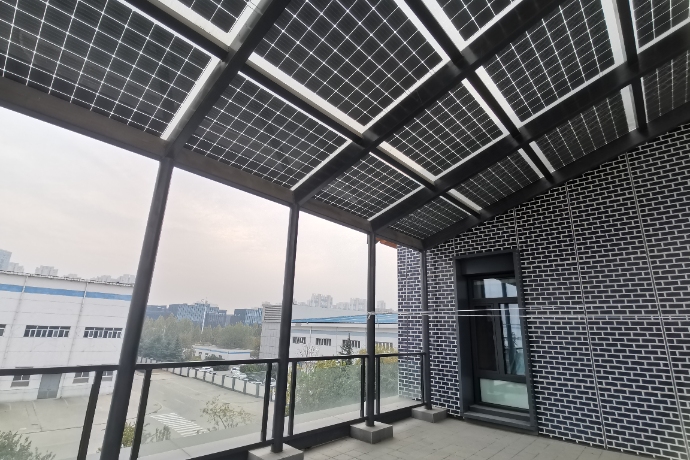Nov. 21, 2025
In Building-Integrated Photovoltaic (BIPV) applications, glass modules often capture attention for their color, transparency, and energy performance. Yet the real strength of a BIPV system lies beneath the surface—in the structural framework and auxiliary materials that hold everything together. Mounting systems, supporting frames, fasteners, and sealing materials form the invisible foundation that ensures stability, safety, and longevity. These components bear structural loads, manage thermal expansion, maintain airtightness and watertightness, and protect electrical circuits. Without a well-engineered support structure, even the most advanced solar glass panels cannot perform reliably over the decades-long lifespan of a building envelope.

A dependable BIPV mounting system integrates structural engineering, material science, and façade technology. Its first responsibility is mechanical safety—supporting wind, snow, and self-weight loads while transferring forces evenly to the main structure. Equally important is flexibility, allowing for small movements caused by temperature changes without compromising the system’s integrity.
Sealing and waterproofing layers prevent moisture ingress and ensure long-term resistance against UV and chemical exposure. Properly designed drainage paths and gasket compression zones protect both the photovoltaic modules and the surrounding façade elements. In addition, concealed cable routing channels simplify maintenance and keep the exterior appearance clean. Finally, mounting systems must allow for easy module replacement, reducing downtime and preserving the façade’s continuity over time.
The engineering of BIPV structures revolves around a balance between strength, durability, and aesthetic precision. Aluminum alloys—most commonly anodized 6000-series materials—are used for their excellent stiffness-to-weight ratio and corrosion resistance, especially in exposed façades and rooftops. Galvanized or stainless steel anchors provide the necessary load transfer at connection points, ensuring long-term stability.
Sealing systems made of EPDM or silicone rubber resist UV degradation and maintain elasticity over years of compression and thermal cycling. Stainless-steel fasteners and clamps offer mechanical reliability and resist galvanic corrosion. Increasingly, system designers are also integrating hidden cable channels within mullions and profiles to protect electrical wiring and maintain architectural cleanliness.
All these components must perform together as a cohesive unit—tested under structural, weathering, and fire-safety standards—to guarantee a safe and durable solar envelope. Proper coordination among engineers, façade consultants, and manufacturers is essential to ensure that each element supports both energy generation and building performance objectives.
Since BIPV is both an electrical and a structural system, it must comply with dual sets of standards. Building codes such as EN 1090 or GB/T 21086 define mechanical strength and structural fabrication requirements, while PV safety standards like IEC 61730 specify electrical insulation and impact resistance. In advanced projects, designers also account for regional wind and snow load maps, seismic zones, and fire-safety ratings.
Testing typically includes cyclic load assessments, wind tunnel simulations, salt spray and humidity resistance, UV exposure, and thermal cycling. By meeting or exceeding these requirements, BIPV mounting systems ensure that façades and roofs remain safe, watertight, and electrically sound for decades of operation—even under challenging environmental conditions.
BIPV is as much about design as it is about technology. A successful mounting system allows architects to realize their creative vision without compromising structural or electrical safety. Concealed frames and edge profiles maintain sleek glass surfaces, while adjustable bracket systems enable precise alignment and module spacing.
Whether used for a transparent skylight, a colorful façade, or a seamless solar roof, the underlying structure must accommodate diverse glass formats and orientation angles. Thermal movement joints, drainage systems, and maintenance pathways are carefully planned to remain functional yet visually unobtrusive. This balance of form and function is what makes BIPV a true synthesis of architecture and renewable energy.
Implementing a high-quality BIPV support system requires close coordination throughout the project lifecycle. Early design stages involve structural load analysis and feasibility studies to select the right materials and connection details. Detailed engineering follows, with modeling, simulation, and prototype testing to verify compliance and optimize performance.
During installation, prefabricated subassemblies and standardized connection modules help reduce on-site work and improve accuracy. Clear documentation and modular replacement design simplify future maintenance. Each step—from concept design to handover—must be guided by both technical discipline and architectural intent.
As one of the leading providers in the BIPV industry, Gain Solar combines its experience in solar glass production with deep expertise in mounting systems and structural engineering. The company offers complete solutions that include aluminum framing systems, weatherproof sealing components, and customized anchoring designs for façades, roofs, and skylights.
Gain Solar’s engineering team supports architects and developers through the full project cycle—from early structural calculations and prototype testing to on-site guidance and long-term maintenance planning. Each solution is tailored to meet local building codes, performance targets, and visual design requirements. Through this integrated approach, Gain Solar ensures that solar architecture is not only energy-efficient but also structurally sound and aesthetically refined.
The success of a BIPV installation depends on more than just efficient solar modules; it relies on the precision and reliability of the structural systems that support them. Mounting components, fasteners, seals, and frames are the silent enablers of every safe, watertight, and visually consistent solar façade or roof. As BIPV continues to merge energy and architecture, these technical foundations will play an even greater role in defining how buildings produce and express power. Gain Solar’s comprehensive structural solutions embody this philosophy—where engineering excellence meets architectural vision to shape the next generation of sustainable buildings.